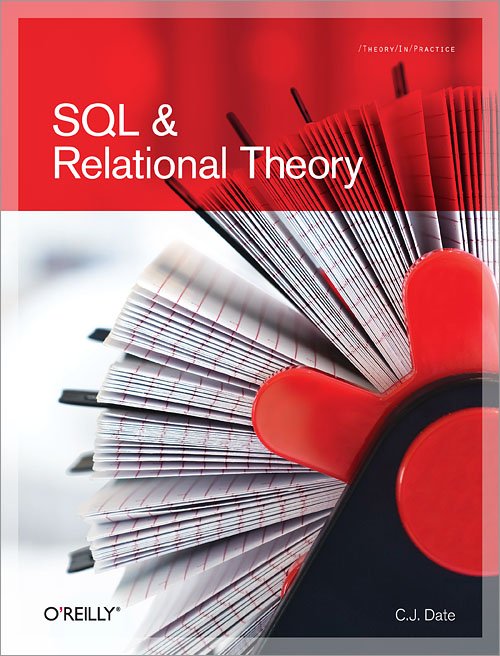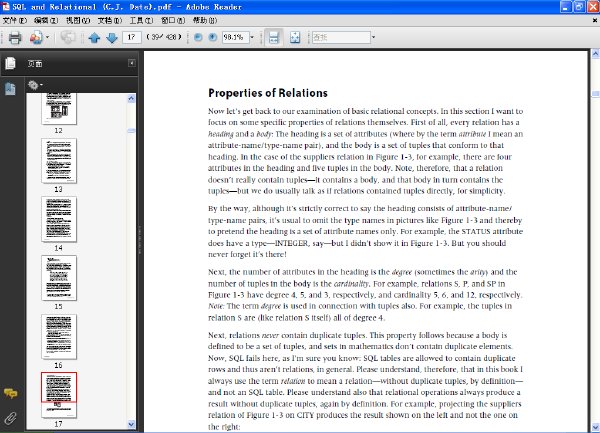《SQL與關系理論》(SQL&Relational Theory)(C.J. Date)清晰版[PDF] 簡介: 中文名 : SQL與關系理論 原名 : SQL&Relational Theory 作者 : C.J. Date 資源格式 : PDF 版本 : 清晰版 出版社 : O'Reilly Media 書號 : 0596523068 發行時間 : 2009年 地區 : 美國 語言 : 英文 簡介 : 內容簡介 : 自E.F Codd於1969年首次定義關系模式以來,數
"《SQL與關系理論》(SQL&Relational Theory)(C.J. Date)清晰版[PDF]"介紹
中文名: SQL與關系理論
原名: SQL&Relational Theory
作者: C.J. Date
資源格式: PDF
版本: 清晰版
出版社: O'Reilly Media
書號: 0596523068
發行時間: 2009年
地區: 美國
語言: 英文
簡介:

內容簡介:
自E.F Codd於1969年首次定義關系模式以來,數據庫理論與實踐就一直在發展。本書獨立於任何SQL,產品,描繪了關系數據庫理論十幾年來的研究進展,為讀者介紹了有關關系數據庫理論的最新知識。任何具有一定SQL知識的人都可以從中的很多方面受益。C.J. Date於1970的早期在IBM開始從事數據庫方面工作。他是一個多產的作者,其著名的教材是“An Introduction to Database Systems(Addison-Wesley)”,該書被廣泛地認為是關於數據庫管理基礎知識的最好教科書之一。數據庫是否應該使用視圖而不是基表來訪問?數據庫中的Null是否使你得到了錯誤的答案,為什麼?關於Null,你又可以做些什麼呢?是否可以編寫一個SQL查詢,通過這個查詢,可以得到在同一個部門中同時工作超過六個月的員工?SQL支持“量化的比較”,但是最好避免使用它們。為什麼?你又該如何來避免使用它們?約束是非常重要的,但是大部分的SQL一產品都沒有恰當地支持它們。為了解決這個問題,你能做些什麼呢?
在關系數據庫系統中,SQL已經成為了事實標准。SQL語言使用非常廣泛,現在流行的所有數據庫系統幾乎都支持SQL。但是,SQL難以使用,它非常復雜,並且很令人費解。本書主要介紹了關系數據庫的原理與SQL的內在關系,闡述了該如何把關系理論直接應用到SQL的應用中,並通過大量的例子以及對其背後理論解釋,幫助讀者編寫出高效而精確的SQL代碼。全書由12章和4個附錄組成,每章後面都給出了一定的練習題,幫助讀者鞏固所學的內容,並在附錄C中給出了這些練習題的答案,因此極大地方便了讀者的學習和使用。
Understanding SQL's underlying theory is the best way to guarantee that your SQL code is correct and your database schema is robust and maintainable. On the other hand, if you're not well versed in the theory, you can fall into several traps. In SQL and Relational Theory, author C.J. Date demonstrates how you can apply relational theory directly to your use of SQL. With numerous examples and clear explanations of the reasoning behind them, you'll learn how to deal with common SQL dilemmas, such as:
Should database access granted be through views instead of base tables?
Nulls in your database are causing you to get wrong answers. Why? What can you do about it?
Could you write an SQL query to find employees who have never been in the same department for more than six months at a time?
SQL supports "quantified comparisons," but they're better avoided. Why? How do you avoid them?
Constraints are crucially important, but most SQL products don't support them properly. What can you do to resolve this situation?
Database theory and practice have evolved since Edgar Codd originally defined the relational model back in 1969. Independent of any SQL products, SQL and Relational Theory draws on decades of research to present the most up-to-date treatment of the material available anywhere. Anyone with a modest to advanced background in SQL will benefit from the many insights in this book.
內容截圖:

目錄:
Chapter 1 Setting the Scene
The Relational Model Is Much Misunderstood
Some Remarks on Terminology
Principles, Not Products
A Review of the Original Model
Model vs. Implementation
Properties of Relations
Base vs. Derived Relations
Relations vs. Relvars
Values vs. Variables
Concluding Remarks
Exercises
Chapter 2 Types and Domains
Types and Relations
Equality Comparisons
Data Value Atomicity
What's a Type?
Scalar vs. Nonscalar Types
Scalar Types in SQL
Type Checking and Coercion in SQL
Collations in SQL
Row and Table Types in SQL
Concluding Remarks
Exercises
Chapter 3 Tuples and Relations, Rows and Tables
What's a Tuple?
Rows in SQL
What's a Relation?
Relations and Their Bodies
Relations Are n-Dimensional
Relational Comparisons
TABLE_DUM and TABLE_DEE
Tables in SQL
Column Naming in SQL
Concluding Remarks
Exercises
Chapter 4 No Duplicates, No Nulls
What's Wrong with Duplicates?
Duplicates: Further Issues
Avoiding Duplicates in SQL
What's Wrong with Nulls?
Avoiding Nulls in SQL
A Remark on Outer Join
Concluding Remarks
Exercises
Chapter 5 Base Relvars, Base Tables
Data Definitions
Updating Is Set Level
Relational Assignment
More on Candidate Keys
More on Foreign Keys
Relvars and Predicates
Relations vs. Types
Exercises
Chapter 6 SQL and Relational Algebra I: The Original Operators
Some Preliminaries
More on Closure
Restriction
Projection
Join
Union, Intersection, and Difference
Which Operators Are Primitive?
Formulating Expressions a Step at a Time
What Do Relational Expressions Mean?
Evaluating SQL Table Expressions
Expression Transformation
The Reliance on Attribute Names
Exercises
Chapter 7 SQL and Relational Algebra II: Additional Operators
Semijoin and Semidifference
Extend
Image Relations
Divide
Aggregate Operators
Image Relations bis
Summarization
Summarization bis
Group and Ungroup
"What If" Queries
What About ORDER BY?
Exercises
Chapter 8 SQL and Constraints
Type Constraints
Type Constraints in SQL
Database Constraints
Database Constraints in SQL
Transactions
Why Database Constraint Checking Must Be Immediate
But Doesn't Some Checking Have to Be Deferred?
Constraints and Predicates
Miscellaneous Issues
Exercises
Chapter 9 SQL and Views
Views Are Relvars
Views and Predicates
Retrieval Operations
Views and Constraints
Update Operations
What Are Views For?
Views and Snapshots
Exercises
Chapter 10 SQL and Logic
Simple and Compound Propositions
Simple and Compound Predicates
Quantification
Relational Calculus
More on Quantification
Some Equivalences
Concluding Remarks
Exercises
Chapter 11 Using Logic to Formulate SQL Expressions
Some Transformation Laws
Example 1: Logical Implication
Example 2: Universal Quantification
Example 3: Implication and Universal Quantification
Example 4: Correlated Subqueries
Example 5: Naming Subexpressions
Example 6: More on Naming Subexpressions
Example 7: Dealing with Ambiguity
Example 8: Using COUNT
Example 9: Join Queries
Example 10: UNIQUE Quantification
Example 11: ALL or ANY Comparisons
Example 12: GROUP BY and HAVING
Exercises
Chapter 12 Miscellaneous SQL Topics
SELECT *
Explicit Tables
Name Qualification
Range Variables
Subqueries
"Possibly Nondeterministic" Expressions
Empty Sets
A BNF Grammar for SQL Table Expressions
Exercises
Appendix The Relational Model
The Relational Model vs. Others
The Relational Model Defined
Objectives of the Relational Model
Some Database Principles
What Remains to Be Done?
Appendix Database Design Theory
The Place of Design Theory
Functional Dependencies and Boyce/Codd Normal Form
Join Dependencies and Fifth Normal Form
Two Cheers for Normalization
Orthogonality
Some Remarks on Physical Design
Concluding Remarks
Exercises
Appendix Answers to Exercises
Chapter 1
Chapter 2
Chapter 3
Chapter 4
Chapter 5
Chapter 6
Chapter 7
Chapter 8
Chapter 9
Chapter 10
Chapter 11
Chapter 12
Appendix Suggestions for Further Reading
Colophon
原名: SQL&Relational Theory
作者: C.J. Date
資源格式: PDF
版本: 清晰版
出版社: O'Reilly Media
書號: 0596523068
發行時間: 2009年
地區: 美國
語言: 英文
簡介:

內容簡介:
自E.F Codd於1969年首次定義關系模式以來,數據庫理論與實踐就一直在發展。本書獨立於任何SQL,產品,描繪了關系數據庫理論十幾年來的研究進展,為讀者介紹了有關關系數據庫理論的最新知識。任何具有一定SQL知識的人都可以從中的很多方面受益。C.J. Date於1970的早期在IBM開始從事數據庫方面工作。他是一個多產的作者,其著名的教材是“An Introduction to Database Systems(Addison-Wesley)”,該書被廣泛地認為是關於數據庫管理基礎知識的最好教科書之一。數據庫是否應該使用視圖而不是基表來訪問?數據庫中的Null是否使你得到了錯誤的答案,為什麼?關於Null,你又可以做些什麼呢?是否可以編寫一個SQL查詢,通過這個查詢,可以得到在同一個部門中同時工作超過六個月的員工?SQL支持“量化的比較”,但是最好避免使用它們。為什麼?你又該如何來避免使用它們?約束是非常重要的,但是大部分的SQL一產品都沒有恰當地支持它們。為了解決這個問題,你能做些什麼呢?
在關系數據庫系統中,SQL已經成為了事實標准。SQL語言使用非常廣泛,現在流行的所有數據庫系統幾乎都支持SQL。但是,SQL難以使用,它非常復雜,並且很令人費解。本書主要介紹了關系數據庫的原理與SQL的內在關系,闡述了該如何把關系理論直接應用到SQL的應用中,並通過大量的例子以及對其背後理論解釋,幫助讀者編寫出高效而精確的SQL代碼。全書由12章和4個附錄組成,每章後面都給出了一定的練習題,幫助讀者鞏固所學的內容,並在附錄C中給出了這些練習題的答案,因此極大地方便了讀者的學習和使用。
Understanding SQL's underlying theory is the best way to guarantee that your SQL code is correct and your database schema is robust and maintainable. On the other hand, if you're not well versed in the theory, you can fall into several traps. In SQL and Relational Theory, author C.J. Date demonstrates how you can apply relational theory directly to your use of SQL. With numerous examples and clear explanations of the reasoning behind them, you'll learn how to deal with common SQL dilemmas, such as:
Should database access granted be through views instead of base tables?
Nulls in your database are causing you to get wrong answers. Why? What can you do about it?
Could you write an SQL query to find employees who have never been in the same department for more than six months at a time?
SQL supports "quantified comparisons," but they're better avoided. Why? How do you avoid them?
Constraints are crucially important, but most SQL products don't support them properly. What can you do to resolve this situation?
Database theory and practice have evolved since Edgar Codd originally defined the relational model back in 1969. Independent of any SQL products, SQL and Relational Theory draws on decades of research to present the most up-to-date treatment of the material available anywhere. Anyone with a modest to advanced background in SQL will benefit from the many insights in this book.
內容截圖:

目錄:
Chapter 1 Setting the Scene
The Relational Model Is Much Misunderstood
Some Remarks on Terminology
Principles, Not Products
A Review of the Original Model
Model vs. Implementation
Properties of Relations
Base vs. Derived Relations
Relations vs. Relvars
Values vs. Variables
Concluding Remarks
Exercises
Chapter 2 Types and Domains
Types and Relations
Equality Comparisons
Data Value Atomicity
What's a Type?
Scalar vs. Nonscalar Types
Scalar Types in SQL
Type Checking and Coercion in SQL
Collations in SQL
Row and Table Types in SQL
Concluding Remarks
Exercises
Chapter 3 Tuples and Relations, Rows and Tables
What's a Tuple?
Rows in SQL
What's a Relation?
Relations and Their Bodies
Relations Are n-Dimensional
Relational Comparisons
TABLE_DUM and TABLE_DEE
Tables in SQL
Column Naming in SQL
Concluding Remarks
Exercises
Chapter 4 No Duplicates, No Nulls
What's Wrong with Duplicates?
Duplicates: Further Issues
Avoiding Duplicates in SQL
What's Wrong with Nulls?
Avoiding Nulls in SQL
A Remark on Outer Join
Concluding Remarks
Exercises
Chapter 5 Base Relvars, Base Tables
Data Definitions
Updating Is Set Level
Relational Assignment
More on Candidate Keys
More on Foreign Keys
Relvars and Predicates
Relations vs. Types
Exercises
Chapter 6 SQL and Relational Algebra I: The Original Operators
Some Preliminaries
More on Closure
Restriction
Projection
Join
Union, Intersection, and Difference
Which Operators Are Primitive?
Formulating Expressions a Step at a Time
What Do Relational Expressions Mean?
Evaluating SQL Table Expressions
Expression Transformation
The Reliance on Attribute Names
Exercises
Chapter 7 SQL and Relational Algebra II: Additional Operators
Semijoin and Semidifference
Extend
Image Relations
Divide
Aggregate Operators
Image Relations bis
Summarization
Summarization bis
Group and Ungroup
"What If" Queries
What About ORDER BY?
Exercises
Chapter 8 SQL and Constraints
Type Constraints
Type Constraints in SQL
Database Constraints
Database Constraints in SQL
Transactions
Why Database Constraint Checking Must Be Immediate
But Doesn't Some Checking Have to Be Deferred?
Constraints and Predicates
Miscellaneous Issues
Exercises
Chapter 9 SQL and Views
Views Are Relvars
Views and Predicates
Retrieval Operations
Views and Constraints
Update Operations
What Are Views For?
Views and Snapshots
Exercises
Chapter 10 SQL and Logic
Simple and Compound Propositions
Simple and Compound Predicates
Quantification
Relational Calculus
More on Quantification
Some Equivalences
Concluding Remarks
Exercises
Chapter 11 Using Logic to Formulate SQL Expressions
Some Transformation Laws
Example 1: Logical Implication
Example 2: Universal Quantification
Example 3: Implication and Universal Quantification
Example 4: Correlated Subqueries
Example 5: Naming Subexpressions
Example 6: More on Naming Subexpressions
Example 7: Dealing with Ambiguity
Example 8: Using COUNT
Example 9: Join Queries
Example 10: UNIQUE Quantification
Example 11: ALL or ANY Comparisons
Example 12: GROUP BY and HAVING
Exercises
Chapter 12 Miscellaneous SQL Topics
SELECT *
Explicit Tables
Name Qualification
Range Variables
Subqueries
"Possibly Nondeterministic" Expressions
Empty Sets
A BNF Grammar for SQL Table Expressions
Exercises
Appendix The Relational Model
The Relational Model vs. Others
The Relational Model Defined
Objectives of the Relational Model
Some Database Principles
What Remains to Be Done?
Appendix Database Design Theory
The Place of Design Theory
Functional Dependencies and Boyce/Codd Normal Form
Join Dependencies and Fifth Normal Form
Two Cheers for Normalization
Orthogonality
Some Remarks on Physical Design
Concluding Remarks
Exercises
Appendix Answers to Exercises
Chapter 1
Chapter 2
Chapter 3
Chapter 4
Chapter 5
Chapter 6
Chapter 7
Chapter 8
Chapter 9
Chapter 10
Chapter 11
Chapter 12
Appendix Suggestions for Further Reading
Colophon
- 上一頁:《深入理解MySQL核心技術》(Understanding MySQL Internals )(Sasha Pachev)清晰版[PDF]
- 下一頁:《從新手到高手C++全方位學習 隨書DVD文件》(范磊)
相關資源:
- [文學圖書]《民族主義的意義與悖論—20-21世紀之交俄羅斯文
- [人文社科]《聖經》(Holy Bible: Authorized King James Version)文字版[EPUB]
- [文學圖書]《現代文學經典:症候式分析》掃描版[PDF]
- [教育科技]《西北干旱半干旱地區根瘤菌的多相分類及系統發育研究》文字版[PDF]
- [少兒圖書]《我們的身體系列》掃描版[PDF]
- [其他圖書]《牛津素描指南:從觀察到描繪》掃描版[PDF]
- [其他圖書]《色鉛筆的溫柔彩繪·彩圖版》掃描版[PDF]
- [計算機與網絡]《UG三維造型與數控加工編程實例精解》掃描版
- [其他圖書]《新型木建築》[壓縮包]
- [人文社科]原聲大碟 -《蝙蝠俠:開戰時刻》(Batman Begins)256K[MP3!]
- [電腦基礎]《時代駿晟SSH實戰項目開發--電子化監控》rmvb[壓縮包]
- [軟件綜合]【iOS】iPhone4、4S/iPhone5 7.0.4固件#最近是不是有很多越獄變白的,刷回來繼續越!#
- [生活圖書]《常見病自我按摩圖解》掃描版[PDF]
- [其他圖書]《子午門洗髓經圖解》文字版[PDF]
- [安全相關軟件]《卡巴斯基全功能安全軟件2010 英文/中文》(Kaspersky Internet Security 2010 EN/CN)9.0.0.736[安裝包]
- [文學圖書]《民國第一夫人宋美齡》掃描版[PDF]
- [應用軟件]《社會科學統計軟件包SPSSV16》(Statistical Package for the Social Sciences)[光盤鏡像],應用軟件、資源下載
- [其他資源綜合]《實用釣魚完全入門》掃描版[PDF]
- [系統工具]《磁盤管理》(Paragon.Hard.Disk.Manager)11WinPE[光盤鏡像]
- [生活圖書]《家常小炒》掃描版 [PDF]
- 《魔獸世界編程寶典--World of Warcraft Addons完全參考手冊》(World of Warcraft Programming: A Guide and Reference for Creating WoW Addons)掃描版[PDF]
- 《影視後期編輯合成技術:Adobe After Effects 7.0》掃描版[PDF]
- 《JavaScript征途》掃描版[PDF]
- 《動態網站項目實訓教程:Dreamweaver CS4+ASP》掃描版[PDF]
- 《數據庫系統概念中文版.pdf》(數據庫系統概念中文版.pdf)影印版[PDF]
- 《Visual Basic編程之道》掃描版[PDF]
- 《ILLUSTRATOR CS5實例教程(第2版)》掃描版[PDF]
- 《ARM9嵌入式系統設計與開發教程》(於明 & 范書瑞 & 曾祥烨)第一版[PDF]
- 《Photoshop CS6時尚服裝設計表現技法》全彩版[PDF]
- 《黑客的戰爭:下一個戰爭地帶》掃描版[PDF]
- 《Ext江湖》掃描版[PDF]
- 《讓Oracle跑得更快——Oracle 10g性能分析與優化思路》掃描版[PDF]
免責聲明:本網站內容收集於互聯網,本站不承擔任何由於內容的合法性及健康性所引起的爭議和法律責任。如果侵犯了你的權益,請通知我們,我們會及時刪除相關內容,謝謝合作! 聯系信箱:[email protected]
Copyright © 電驢下載基地 All Rights Reserved



